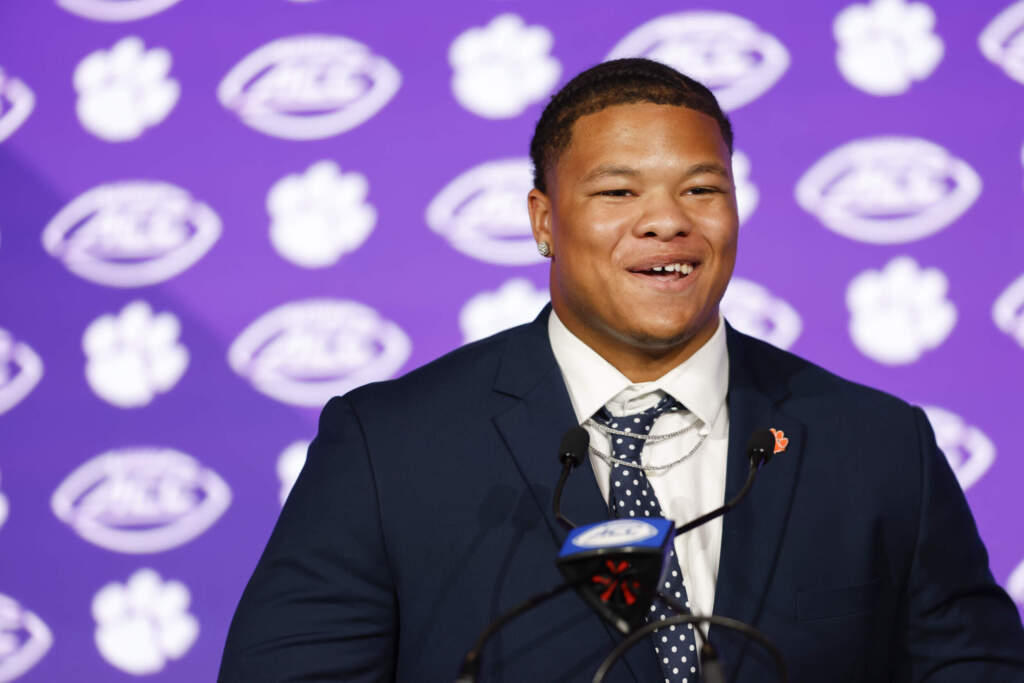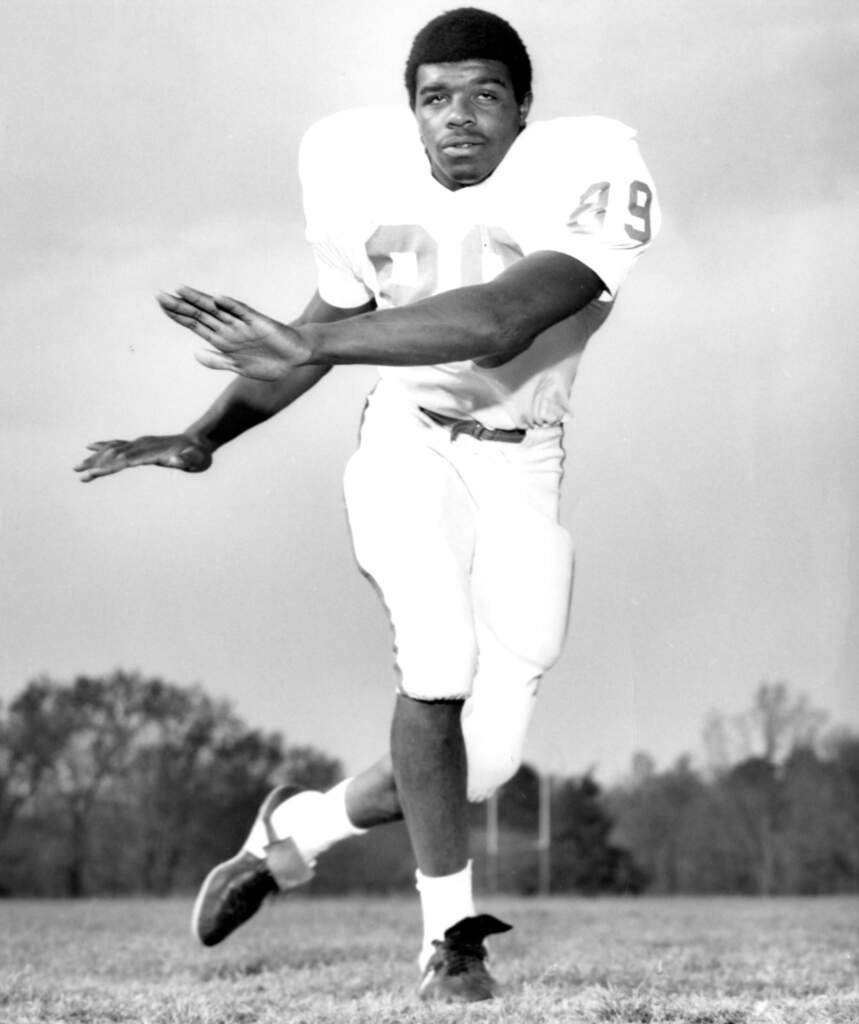Note: The following appears in the Kent State gameday football program. To purchase a copy of the program while supplies last, send a check for $7 to Clemson Athletic Communications; P.O. Box 31; Clemson, SC 29633 with your return address.
RESOLVE FOR 2016 SEASON
Clemson’s drive to the 2016 national championship really began on Jan. 11, 2016. The Tigers had been 14-0 during the 2015 season, the only perfect FBS team, entering the national championship game against Alabama, but came up short 45-40 in one of the best national title games in history.
The locker room after that game was one of disappointment, but also one of resolve. That resolve was led by Dabo Swinney, who told his team, “It took us 34 years to get to this game, but it is not going to take us 34 years to get back.”
You could see it on the faces of the players in that locker room. While it had been a landmark, record-setting and satisfying season in 2015, the players and coaches were not too satisfied.
As the players left the locker room in Arizona that night, there was a motivation to get back to the final game the following season.
OPENING WIN AT AUBURN
Dabo Swinney is always ready for the season opener, but opening at Auburn was a little extra special for the Alabama graduate. He had been involved in that rivalry for over a decade and had suffered some heartbreaks at Jordan-Hare Stadium.
That would not be the case on this warm night in Auburn. While former Clemson defensive coordinator Kevin Steele held the ACC Tigers to season lows in points (19) and total yards (399), Clemson came out on top with a 19-13 victory.
Clemson had a 19-6 lead thanks to a diving touchdown catch by Hunter Renfrow on a third-and-goal situation with 10 minutes left, but Auburn came back to 19-13 and had the ball for a final drive. But Jadar Johnson batted away two straight “Hail Mary” passes and Clemson earned a hard-fought win over an Auburn team that finished the season in the top 25 of both polls.
While some media downplayed the importance of No. 2 Clemson’s victory, the Tigers were the only top-25 team to win a game on an opponent’s home field in the first week of the season. It was Clemson’s first season-opening road victory over a team currently in the SEC since the Tigers won at Georgia to open the 1903 season under head coach John Heisman.
EDMOND DELIVERS, PART I
Deshaun Watson and Lamar Jackson had lit up the scoreboards the first month of the 2016 season, and they were set to face each other in a primetime matchup that would be talked about for years. Not since November 1977, when Notre Dame and quarterback Joe Montana came to Clemson to face Clemson and quarterback Steve Fuller, had Memorial Stadium seen such a talented matchup of signal-callers.
Louisville entered the game ranked No. 3 in the nation and Jackson was averaging over 500 yards per game after he shocked the nation with a 63-20 win over Florida State, who was No. 2 in the nation entering that game.
With ESPN College GameDay in town and the Clemson crowd ready for a night thriller, the Tigers jumped out to a 28-10 lead in the first half, as Watson had two passing touchdowns to Deon Cain and one to roommate Artavis Scott.
However, Louisville had earned their No. 3 ranking and showed the audience the dynamic nature of its attack. Jackson led Louisville on a 26-0 run, as he ran for one score and threw for two.
It was time for Watson to return serve. Thanks to Scott’s 77-yard kickoff return, perhaps the most important play of the regular season, Watson only had to take the Tigers 23 yards for a touchdown. He did it in just two plays, hitting Mike Williams for a 20-yard score.
The back-and-forth scoring continued late into the game. After a passing touchdown to Jordan Leggett allowed Clemson to retake the lead, Jackson took the Cardinals down the field. They had a fourth-and-12 at the Clemson 14 with just seconds left. Jackson connected with James Quick near the sideline. An alert Marcus Edmond closed quickly and forced Quick out of bounds at the three, one yard short of a first down.
The 42-36 victory was the third in a row by seven points or less for the Tigers against Louisville. It is just the second time in history and first since three straight wins over Duke from 1965-67 that Clemson beat a team in three consecutive years by a touchdown or less.
EDMOND DELIVERS, PART II
NC State came to Clemson with a 4-1 record and had a history of giving the Tigers trouble when they were having a good year. In 2011, Clemson was No. 7 in the nation, but the Wolfpack beat the Tigers 37-13. That was the last time Clemson had lost to an unranked foe.
Clemson had some turnover problems, including the only “pick six” of Deshaun Watson’s career, high school or college. On the final play of regulation, Kyle Bambard lined up for a 33-yard field-goal attempt to give the Wolfpack the upset of the day in college football. But his attempt was wide right and the game went into overtime.
Prior to overtime, Hunter Renfrow told the offensive coaches about an NC State defensive back who was guarding him a certain way and that a specific play would work. On Clemson’s possession, the Tiger offensive coaches took Renfrow’s advice and Watson hit Artavis Scott over the middle for a touchdown.
NC State went for the score on its first play in overtime, but Marcus Edmond made his second game-saving play of the season, hauling in an interception in the endzone that proved to be the first defensive walkoff play for the Tigers since 1997, when Rahim Abdullah had an overtime, game-ending interception for a touchdown against Duke.
TALLAHASSEE THRILLER
The 2016 schedule featured three games in opponent stadiums where Dabo Swinney had never won. The Tigers were a combined 0-8 at Auburn, Georgia Tech and Florida State since Swinney became head coach in 2008. Having conquered Auburn and Georgia Tech stadium demons, the Tigers headed to Tallahassee on October 29 to attempt to make it a clean sweep and continue to show this was going to be a special season.
Clemson was masterful in the first quarter and fourth quarter, scoring 31 points in those quarters combined. But the Seminoles won the middle two quarters 28-6 and had a 28-20 lead entering the fourth quarter.
Watson had not had to lead many comebacks previously, but they were commonplace in his final season. First, he led Clemson on a 75-yard touchdown drive that culminated with a Wayne Gallman two-yard touchdown run.
Then, Greg Huegel made a clutch 46-yard field goal to put Clemson ahead 29-28 with just over five minutes left. But Florida State came back on another Dalvin Cook touchdown run, this time from eight yards out with 3:23 left.
Watson had been saving some plays for Jordan Leggett the entire game, and he completed four passes for 70 yards to the talented tight end on the final drive. That included a 34-yard passing touchdown to the Tiger All-American with 2:06 left. Leggett showed his athletic ability by diving over a defender to complete the play.
Florida State still had 2:06 remaining in the game to drive for a tying field goal and send the game into overtime, but consecutive sacks by Dexter Lawrence and Ben Boulware snuffed out the drive and Clemson had its first win in Tallahassee since 2006 and just its second since 1989.
COMPLETING A PROMISE
Deshaun Watson and Mike Williams were on the cover of the Clemson vs. South Carolina gameday program in 2016. While they were not seniors in terms of athletic eligibility, they were academically, and obviously ready to turn professional. They knew and Clemson fans knew that this would be their final appearance in Memorial Stadium.
They made that final appearance count as Watson totaled six passing touchdowns, the most ever by a Tiger against South Carolina, and Williams became the first Tiger with three receiving touchdowns against the Gamecocks. All three came in the first half.
Their performance led Clemson to a 56-7 win, the largest victory margin ever for an ACC team over an SEC team.
When Watson was a freshman, he stated that he was not going to lose to South Carolina during his career. Clemson had lost five games in a row to the Gamecocks before he joined the Tiger program.
In legendary fashion, including a performance with a torn ACL as a freshman, Watson lived up to that statement with a 3-0 record. In the three games, he completed 61-79 passes for 895 yards and nine touchdowns against just one interception. The 207.4 passing efficiency was his best career figure against an opponent.
BACK-TO-BACK ACC TITLES
The ACC Championship Game in Orlando, Fla., which was similar to the 2015 title clincher, saw the Tigers victorious with a 42-35 win when Clemson’s offense was at its best. That included Deshaun Watson, who was the offensive MVP for the second straight year.
As it had four times previously in 2016, the Tigers scored the first two touchdowns of the game, first on a three-yard run by Watson, then on a 21-yard pass from Watson to Jordan Leggett.
Watson would have his best combination passing and running game of the year, as he passed for 288 yards and rushed for 88 yards, as Clemson beat Virginia Tech for the fourth straight time, including two wins in ACC title games. He finished with five total touchdowns, as the Clemson offense had just one turnover and averaged 6.3 yards per play.
Cordrea Tankersley led the defense with two interceptions and freshman Dexter Lawrence had two sacks, as Clemson recorded its 12th win of the season, including its eighth against a team that finished the year with a winning record.
The victory gave Clemson back-to-back ACC championships for the first time in 28 years.
THE RETURN TO ARIZONA
The day after the ACC Championship Game victory over Virginia Tech, Clemson was the No. 2 seed in the College Football Playoff and was assigned to Glendale, Ariz., for a matchup with No. 3 seed and No. 2 ranked Ohio State in the Fiesta Bowl. The Buckeyes were the first program to reach the playoff without winning their conference title.
The Tigers had the Buckeyes just where they wanted them from an intangible standpoint, and it was never a contest. Clemson’s 31-0 triumph was so dominant that Dabo Swinney pulled his offensive starters for the last two drives. The Tigers gained 205 rushing yards and 265 passing yards against the nation’s third-best defense that had allowed just 282 yards per game.
The shutout was the first for the Buckeye program since 1993 and the first for Urban Meyer, the third-winningest coach in college football history in terms of percentage, in his 194 games as a head coach.
On the same day, Alabama defeated Washington 24-7 in the other semifinal in Atlanta, setting up the first rematch of a national-championship-deciding game in college football history.
THE REMATCH
Alabama had won 26 games in a row, the longest winning streak by an SEC team since 1980, and had won 16 games in row over top-25 teams, tied for the longest streak since the poll era began in 1936.
While Alabama was noted for its defense in winning the national championship in 2015, its numbers were even better in 2016. The Crimson Tide allowed just two yards per carry and 244 total yards per game, 40 yards per game fewer than any other team.
Dabo Swinney bristled when he was asked by some media members if they could move the ball at all against the Crimson Tide, who had five first-team All-Americans on defense, including national defensive player-of-the-year Jonathan Allen.
Both teams were in the top 10 in total defense and scoring defense entering the game, and it appeared it would be a defensive battle in the first half. Alabama led 14-7 at halftime, the first time all year Clemson did not have the halftime lead.
Alabama could have taken a dominant 21-7 lead early in the third quarter when the ball was stripped from Wayne Gallman and recovered by Ryan Anderson, but Hunter Renfrow made the hidden play-of-the-game by stopping Anderson short of the goal line. Clemson then held the Crimson Tide to a field goal.
Alabama actually increased its lead to 24-14 through three quarters.
Just as Clemson had won 51 games in a row when leading entering the fourth quarter prior to the 2015 title game, Nick Saban had won 97 games in a row with a double-digit lead as a head coach entering the fourth quarter.
The cumulative affect of the Tiger offense took its toll on Alabama in the fourth quarter. First, The Tigers drove 72 yards in nine plays to cut the margin to 24-21 when Deshaun Watson connected with Mike Williams on a four-yard touchdown pass.
After a trade of punts, Clemson drove 88 yards in six plays to take a 28-24 lead with 4:38 left. But Alabama drove right back.
The Crimson Tide was faced with a third-and-16 and a fourth-and-one, but converted. One trick play later and a 30-yard run by Jalen Hurts, and Alabama had a 31-28 lead with 2:07 left. Just 2:07 until a fifth national championship in eight years, something no one had ever done.
What followed was the “drive of the ages” for the Clemson program.
Sixty-eight yards away with 61 seconds on the clock after C.J. Fuller’s kickoff return was the challenge.
Clemson drove to the Alabama two yard line with just six seconds left behind great catches by Williams and Jordan Leggett.
Knowing this could be the final play of the game and his career, Watson rolled to his right and found an open Renfrow in the endzone. He went to the ground with the ball in his stomach. There was just one second left on the clock.
The catch, Renfrow’s 10th of the game, the most against Alabama in four years, gave Clemson a 34-31 lead. The ensuing extra point made the score 35-31. How fitting that Clemson had scored 35 points when it had been 35 years since the Tigers had won their only previous national championship.
After recovering an onside kick, just Clemson’s fourth onside kick recovery in the last 39 years, all the Tigers had to do was kneel down. Fittingly, Watson had the ball in his hands on the last play.
 Duke
Duke 
 Florida State
Florida State  Louisville
Louisville  Furman
Furman  South Carolina
South Carolina  LSU
LSU  Troy
Troy  Georgia Tech
Georgia Tech  Syracuse
Syracuse  North Carolina
North Carolina  Boston College
Boston College  SMU
SMU 






